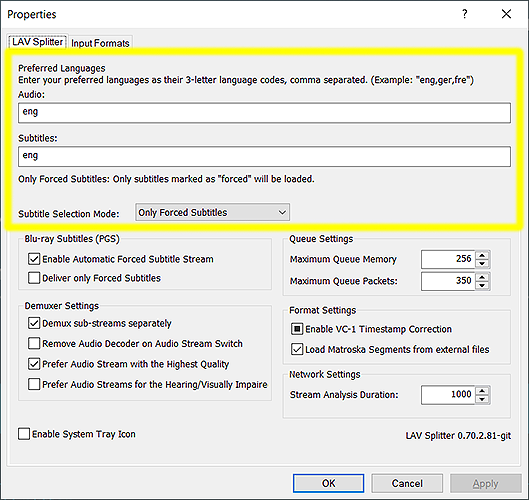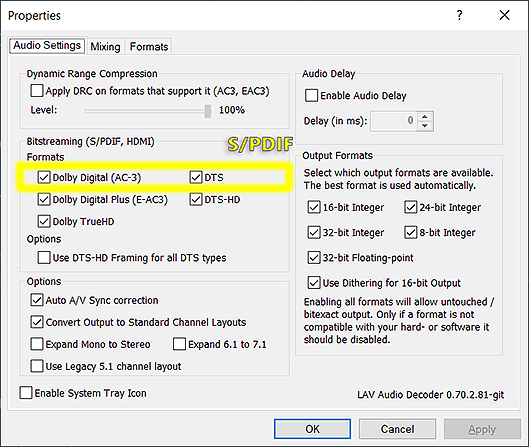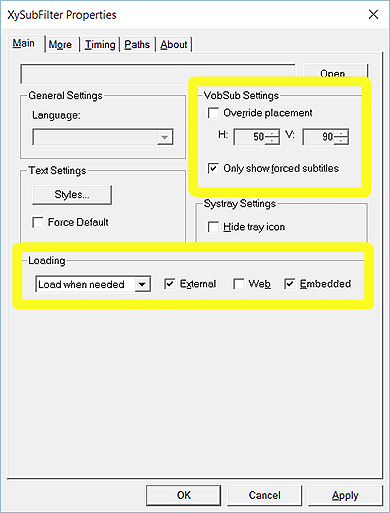2015-03-27, 08:14
3. LAV FILTERS & XYSUBFILTER SET UP
We will now configure LAV Filters & XySubFilter. Internal copies of these filters are installed with DSPlayer. Set up assumes internal filters are used.
Pressing O during playback brings up a list of filters loaded with each video. This can be useful to ensure the correct filters are being used. Titles of internal filters start with an i (e.g. (i) LAV Splitter Source).
Configure LAV Filters: Player settings -> DSPlayer -> Filters management -> Internal filters

The recommendation is to configure each filter with its standard configuration panel as opposed to the Kodi GUI.
Select Open property page to access the configuration panel:

LAV Splitter (- Splitter)
In LAV Splitter, we are primarily concerned with delivering the correct audio and subtitle streams with each video. Specify a default audio and subtitle language. Then choose a default subtitle selection mode (e.g. Forced for English speakers).
The first Blu-ray Subtitles (PGS) box can safely be left checked. PGS subtitles are graphic subtitles embedded in Blu-ray rips (mkvs). Checking Deliver only Forced Subtitles can sometimes result in PGS subtitles not displaying at all with some files.

LAV Video (- Video decoder)
The main setting to be concerned with in LAV Video is the type of hardware acceleration to be used. Hardware acceleration reduces the load on the CPU by offloading video decoding to the GPU. Use of a fixed-function hardware decoder should have minimal impact on madVR. However, it can significantly reduce the load placed on the CPU, as well as reduce noise and heat. Setting hardware acceleration to None means all video will be decoded using software decoding. The effectiveness of software decoding will depend on the speed of your CPU.
The recommendation for hardware acceleration remains the same across hardware manufacturers:
*NVIDIA CUVID is less efficient with regards to performance and power consumption. The justification for this claim comes from this post.
*DXVA2 (copy-back) can be used by any hardware that supports DXVA2. The copy-back in name means that every video texture is copied back from GPU memory to CPU memory after decoding, so some additional system RAM is consumed. DXVA2 (native) is known to have issues with chroma quality on some systems and is not recommended for use with madVR.
*D3D11 must have the Hardware Device to use set to Automatic (Native). Otherwise, a version of copy-back is used that is slightly slower than DXVA2 (copy-back) with no additional quality benefits. madVR doesn't care if DXVA2 (copy-back) or D3D11 Native are selected. Both are appropriate choices.
madVR features currently unsupported by D3D11 Native:
madVR features noticeably faster with D3D11 Native:
Be sure to check all supported Resolutions and Codecs for HW for the GPU. Documentation for the GPU should indicate video codecs and resolutions supported with hardware acceleration.
Leave the software deinterlacing options alone, as deinterlacing will be handled by madVR. Software deinterlacing does not work with any of the native variants of hardware decoding.

Users struggling with x86 software decoding of HEVC content with LAV Video may want to substitute the Strongene Lentoid HEVC/H.265 Decoder, which offers a significant performance boost. This would require the use of an Extra external filter or Media rules and Filters configuration. LAV Video is the fastest software decoder for x64 (64-bit) DSPlayer.
LAV Audio (- Audio decoder)
Audio codecs are the focus of configuring LAV Audio. The items that are checked will be bitstreamed. Those left unchecked will be unpackaged and sent as multichannel PCM. What can be bitstreamed depends on the audio equipment used (e.g. AV receiver or television) and the type of output (HDMI or S/PDIF). Users of S/PDIF are limited to Dolby Digital (AC3) and DTS and should leave all other boxes unchecked.
Note: Dolby Atmos (via Dolby TrueHD) and DTS:X (via DTS-HD) must be bitstreamed. There is no decoding to PCM on PC.
Note: If using ReClock for media speed correction, it advised all audio be output as PCM (uncheck all boxes, with the above limitation in mind).
Convert Output to Standard Channel Layouts
Adds silent channels to PCM audio streams to match the layout selected in Windows Sounds settings. This prevents some audio devices from misinterpreting the layout of some mulitichannel PCM tracks resulting in some channels being sent to the wrong speakers.
Use Legacy 5.1 channel layout
Check this box if your surround speakers are in the back as opposed to the sides. The default configuration is to have the surround speakers at the sides. This only impacts audio decoded by LAV Audio. Bitstreams are passed through.
Mixing
When bitstreaming is disabled, LAV Audio does the decoding. The Windows Mixer is not useable in WASAPI exclusive mode. So using the Mixing tab opens the possibility to add mixing: converting the output to different channel layouts, altering the volume of specific channels and matrix encoding to Dolby Pro Logic II. These options should be left alone for most users unless you know what you are doing.

Note: It is possible to manually update LAV Filters to the latest version if you are impatient about waiting for a new DSPlayer release. Take the 32-bit or 64-bit LAV Filters installation files and copy them to the following directory (overwriting the old files):
Program Files (x86)\Kodi\system\players\dsplayer\LAVFilters
You may want to backup the existing files in that directory in case something goes wrong.
XySubFilter (- Subtitle filter)
XySubFilter is the subtitle renderer. The benefit of XySubFilter is that it does not render subtitles directly over the video, and instead communicates with the video renderer allowing it to do what it wants with the subtitle and move it as necessary. All subtitles are rendered in high definition with special care given to language formatting.
Subtitles are enabled in Kodi from the Audio Settings menu, which is accessible during playback.
Configure XySubFilter: Player settings -> DSPlayer -> Filters management -> Internal filters -> - Subtitle filter
Loading:
Load when needed: Load only when specified by the subtitle selection mode in LAV Splitter.
Always load: Load any subtitle track matching the default language.
VobSub Settings:
VobSub/PGS subtitles are embedded in mkvs from DVD and Blu-ray rips. The lone setting to be concerned with is Only show forced subtitles. Only subtitles marked as forced will be displayed when checked. A forced PGS subtitle stream must be enabled in LAV Splitter for this setting to be functional, and because these are graphic (bitmap) subtitles, it is not possible to change the color or size.
Tip: From experience, use of XySubFilter will slightly reduce the performance of madVR and use quite a bit of VRAM. This is likely due to the fact subtitles are added to the pre-resized image making madVR work harder. To reduce this impact, check the box optimize subtitle quality for performance instead of quality in the trade quality for performance section of madVR's settings. Those having trouble with XySubFilter should consider substituting it with another subtitle filter and adding that subtitle filter as an Extra external filter.

- Extra external filter
Additional filters can be added to the filters covered above. It is possible to include up to three external filters that will be applied to all media. The role of the extra filter is determined by its type (e.g. audio decoder, video decoder, etc.). The purpose of adding an extra external filter is to use features not offered by LAV Filters or XySubFilter.
The most common extra filter used with DSPlayer is FFDShow. Adding FFDShow RAW (ffdraw), for example, makes it possible to use FFDShow-compatible applications such as the SmoothVideo Project (SVP).
The filters below are popular additions to DSPlayer:
That concludes filters set up. So, on to madVR...
We will now configure LAV Filters & XySubFilter. Internal copies of these filters are installed with DSPlayer. Set up assumes internal filters are used.
Pressing O during playback brings up a list of filters loaded with each video. This can be useful to ensure the correct filters are being used. Titles of internal filters start with an i (e.g. (i) LAV Splitter Source).
Configure LAV Filters: Player settings -> DSPlayer -> Filters management -> Internal filters

The recommendation is to configure each filter with its standard configuration panel as opposed to the Kodi GUI.
Select Open property page to access the configuration panel:

LAV Splitter (- Splitter)
In LAV Splitter, we are primarily concerned with delivering the correct audio and subtitle streams with each video. Specify a default audio and subtitle language. Then choose a default subtitle selection mode (e.g. Forced for English speakers).
The first Blu-ray Subtitles (PGS) box can safely be left checked. PGS subtitles are graphic subtitles embedded in Blu-ray rips (mkvs). Checking Deliver only Forced Subtitles can sometimes result in PGS subtitles not displaying at all with some files.

LAV Video (- Video decoder)
The main setting to be concerned with in LAV Video is the type of hardware acceleration to be used. Hardware acceleration reduces the load on the CPU by offloading video decoding to the GPU. Use of a fixed-function hardware decoder should have minimal impact on madVR. However, it can significantly reduce the load placed on the CPU, as well as reduce noise and heat. Setting hardware acceleration to None means all video will be decoded using software decoding. The effectiveness of software decoding will depend on the speed of your CPU.
The recommendation for hardware acceleration remains the same across hardware manufacturers:
- Intel: D3D11 (Win 8+) or DXVA2 (copy-back)
- AMD: D3D11 (Win 8+) or DXVA2 (copy-back)
- Nvidia: D3D11 (Win 8+) or DXVA2 (copy-back)
*NVIDIA CUVID is less efficient with regards to performance and power consumption. The justification for this claim comes from this post.
*DXVA2 (copy-back) can be used by any hardware that supports DXVA2. The copy-back in name means that every video texture is copied back from GPU memory to CPU memory after decoding, so some additional system RAM is consumed. DXVA2 (native) is known to have issues with chroma quality on some systems and is not recommended for use with madVR.
*D3D11 must have the Hardware Device to use set to Automatic (Native). Otherwise, a version of copy-back is used that is slightly slower than DXVA2 (copy-back) with no additional quality benefits. madVR doesn't care if DXVA2 (copy-back) or D3D11 Native are selected. Both are appropriate choices.
madVR features currently unsupported by D3D11 Native:
- IVTC and GPU hardware deinterlacing;
- black bar detection.
madVR features noticeably faster with D3D11 Native:
- HDR tone mapping highlight recovery strength;
- 4K HEVC on older systems with weak CPU/RAM architecture.
Be sure to check all supported Resolutions and Codecs for HW for the GPU. Documentation for the GPU should indicate video codecs and resolutions supported with hardware acceleration.
Leave the software deinterlacing options alone, as deinterlacing will be handled by madVR. Software deinterlacing does not work with any of the native variants of hardware decoding.

Users struggling with x86 software decoding of HEVC content with LAV Video may want to substitute the Strongene Lentoid HEVC/H.265 Decoder, which offers a significant performance boost. This would require the use of an Extra external filter or Media rules and Filters configuration. LAV Video is the fastest software decoder for x64 (64-bit) DSPlayer.
LAV Audio (- Audio decoder)
Audio codecs are the focus of configuring LAV Audio. The items that are checked will be bitstreamed. Those left unchecked will be unpackaged and sent as multichannel PCM. What can be bitstreamed depends on the audio equipment used (e.g. AV receiver or television) and the type of output (HDMI or S/PDIF). Users of S/PDIF are limited to Dolby Digital (AC3) and DTS and should leave all other boxes unchecked.
Note: Dolby Atmos (via Dolby TrueHD) and DTS:X (via DTS-HD) must be bitstreamed. There is no decoding to PCM on PC.
Note: If using ReClock for media speed correction, it advised all audio be output as PCM (uncheck all boxes, with the above limitation in mind).
Convert Output to Standard Channel Layouts
Adds silent channels to PCM audio streams to match the layout selected in Windows Sounds settings. This prevents some audio devices from misinterpreting the layout of some mulitichannel PCM tracks resulting in some channels being sent to the wrong speakers.
Use Legacy 5.1 channel layout
Check this box if your surround speakers are in the back as opposed to the sides. The default configuration is to have the surround speakers at the sides. This only impacts audio decoded by LAV Audio. Bitstreams are passed through.
Mixing
When bitstreaming is disabled, LAV Audio does the decoding. The Windows Mixer is not useable in WASAPI exclusive mode. So using the Mixing tab opens the possibility to add mixing: converting the output to different channel layouts, altering the volume of specific channels and matrix encoding to Dolby Pro Logic II. These options should be left alone for most users unless you know what you are doing.

Note: It is possible to manually update LAV Filters to the latest version if you are impatient about waiting for a new DSPlayer release. Take the 32-bit or 64-bit LAV Filters installation files and copy them to the following directory (overwriting the old files):
Program Files (x86)\Kodi\system\players\dsplayer\LAVFilters
You may want to backup the existing files in that directory in case something goes wrong.
XySubFilter (- Subtitle filter)
XySubFilter is the subtitle renderer. The benefit of XySubFilter is that it does not render subtitles directly over the video, and instead communicates with the video renderer allowing it to do what it wants with the subtitle and move it as necessary. All subtitles are rendered in high definition with special care given to language formatting.
Subtitles are enabled in Kodi from the Audio Settings menu, which is accessible during playback.
Configure XySubFilter: Player settings -> DSPlayer -> Filters management -> Internal filters -> - Subtitle filter
Loading:
Load when needed: Load only when specified by the subtitle selection mode in LAV Splitter.
Always load: Load any subtitle track matching the default language.
VobSub Settings:
VobSub/PGS subtitles are embedded in mkvs from DVD and Blu-ray rips. The lone setting to be concerned with is Only show forced subtitles. Only subtitles marked as forced will be displayed when checked. A forced PGS subtitle stream must be enabled in LAV Splitter for this setting to be functional, and because these are graphic (bitmap) subtitles, it is not possible to change the color or size.
Tip: From experience, use of XySubFilter will slightly reduce the performance of madVR and use quite a bit of VRAM. This is likely due to the fact subtitles are added to the pre-resized image making madVR work harder. To reduce this impact, check the box optimize subtitle quality for performance instead of quality in the trade quality for performance section of madVR's settings. Those having trouble with XySubFilter should consider substituting it with another subtitle filter and adding that subtitle filter as an Extra external filter.

- Extra external filter
Additional filters can be added to the filters covered above. It is possible to include up to three external filters that will be applied to all media. The role of the extra filter is determined by its type (e.g. audio decoder, video decoder, etc.). The purpose of adding an extra external filter is to use features not offered by LAV Filters or XySubFilter.
The most common extra filter used with DSPlayer is FFDShow. Adding FFDShow RAW (ffdraw), for example, makes it possible to use FFDShow-compatible applications such as the SmoothVideo Project (SVP).
The filters below are popular additions to DSPlayer:
- LAV Filters (Splitter/Video/Audio): http://forum.doom9.org/showthread.php?t=156191
- Xy-VSFilter (Subtitle): http://forum.doom9.org/showthread.php?t=168282
- XySubFilter (Subtitle): http://forum.doom9.org/showthread.php?t=168282
- Strongene Lentoid HEVC/H.265 Decoder (Video): http://www.strongene.com/en/downloads/do...Center.jsp
- FFDShow Audio (Audio/Extra): http://sourceforge.net/projects/ffdshow-tryout/
- FFDShow RAW (Extra): http://sourceforge.net/projects/ffdshow-tryout/
That concludes filters set up. So, on to madVR...
